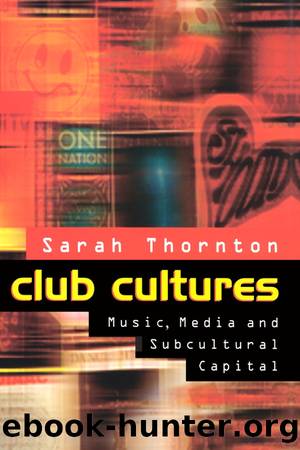Club Cultures by Thornton Sarah;

Author:Thornton, Sarah; [THORNTON, SARAH]
Language: eng
Format: epub
Publisher: Polity Press
Published: 2017-08-13T00:00:00+00:00
Mungham searches for the normal, the average, the routine and the mundane. He positions his study as a counterbalance to sociologyâs orientation toward the conspicuous and bizarre, repeatedly straining to emphasize the conformity, conservatism and âsheer ordinariness of this corner of youth cultureâ (Mungham 1976: 101). In the end, Mungham describes the dance as a âmechanical configurationâ and as a âMecamization of the sexual impulseâ (Mungham 1976: 92). Despite his ethnographic observation, he projects a âMass Societyâ style vision on to the Mecca dancers, portraying them in a way not unlike Adorno depicted jitterbug dancers of the 1940s as ârhythmically obedient ⦠battalions of mechanical collectivityâ (Adorno 1941/1990: 40).
Both Hebdige and Mungham define subcultures and mainstreams against each other. Their antithesis partly derives from the high cultural ideologies in which both formulations are entangled. Hebdige perceives his mainstream as bourgeois and his subcultural youth as an artistic vanguard. Mungham sees his mainstream as a stagnant âmassâ, only their deviant others are, by implication, creative and changing. Although assigned different class characteristics, both âmainstreamsâ are devalued as normal, conventional majorities.
In her article âDance and social fantasyâ, Angela McRobbie questions the basis of these value judgements but still preserves their binary structure (cf. McRobbie 1984). McRobbie maintains the opposition between mainstream ârespectable city discosâ and âsubcultural alternativesâ, but instead of exclusively celebrating the latter, she suggests that dancing offers possibilities of creative expression, control and resistance for girls and women in either place. In several essays, McRobbie has explored the substantial complications that gender poses to these distinctions, but she stops short of disputing the dualistic paradigm (cf. McRobbie 1991).
The mainstream-subculture divide is not the only dichotomy to which the musical worlds of youth have been subject. Other sociologists contrast the culture of middle-class students with that of working-class early school-leavers. For example, Simon Frith outlines a split between a mostly middle-class âsixth-form cultureâ of individualists who buy albums, listen to progressive rock and go to concerts and a working-class âlower-fifth-form cultureâ of cult followers who buy singles, listen to âcommercialâ music and go to discos (cf. Frith 1981a). He links these research findings to a broader distinction between rock culture and pop culture:
the division of musical tastes seemed to reflect class differences: on the one hand, there was the culture of middle-class rock â pretentious and genteel, obsessed with bourgeois notions of art; on the other hand, there was the culture of working-class pop â banal, simple-minded, based on the formulas of a tightly knit body of business men. (Frith 1981a: 213â14)
Download
This site does not store any files on its server. We only index and link to content provided by other sites. Please contact the content providers to delete copyright contents if any and email us, we'll remove relevant links or contents immediately.
| Africa | Americas |
| Arctic & Antarctica | Asia |
| Australia & Oceania | Europe |
| Middle East | Russia |
| United States | World |
| Ancient Civilizations | Military |
| Historical Study & Educational Resources |
The Dawn of Everything by David Graeber & David Wengrow(1566)
The Bomber Mafia by Malcolm Gladwell(1518)
Facing the Mountain by Daniel James Brown(1428)
Submerged Prehistory by Benjamin Jonathan; & Clive Bonsall & Catriona Pickard & Anders Fischer(1375)
Tip Top by Bill James(1291)
Wandering in Strange Lands by Morgan Jerkins(1279)
Evil Geniuses: The Unmaking of America: A Recent History by Kurt Andersen(1269)
Red Roulette : An Insider's Story of Wealth, Power, Corruption, and Vengeance in Today's China (9781982156176) by Shum Desmond(1267)
The Way of Fire and Ice: The Living Tradition of Norse Paganism by Ryan Smith(1255)
Driving While Brown: Sheriff Joe Arpaio Versus the Latino Resistance by Terry Greene Sterling & Jude Joffe-Block(1229)
American Kompromat by Craig Unger(1213)
F*cking History by The Captain(1196)
It Was All a Lie by Stuart Stevens;(1191)
American Dreams by Unknown(1153)
Treasure Islands: Tax Havens and the Men who Stole the World by Nicholas Shaxson(1149)
Evil Geniuses by Kurt Andersen(1142)
White House Inc. by Dan Alexander(1122)
The First Conspiracy by Brad Meltzer & Josh Mensch(1075)
The Fifteen Biggest Lies about the Economy: And Everything Else the Right Doesn't Want You to Know about Taxes, Jobs, and Corporate America by Joshua Holland(1028)
